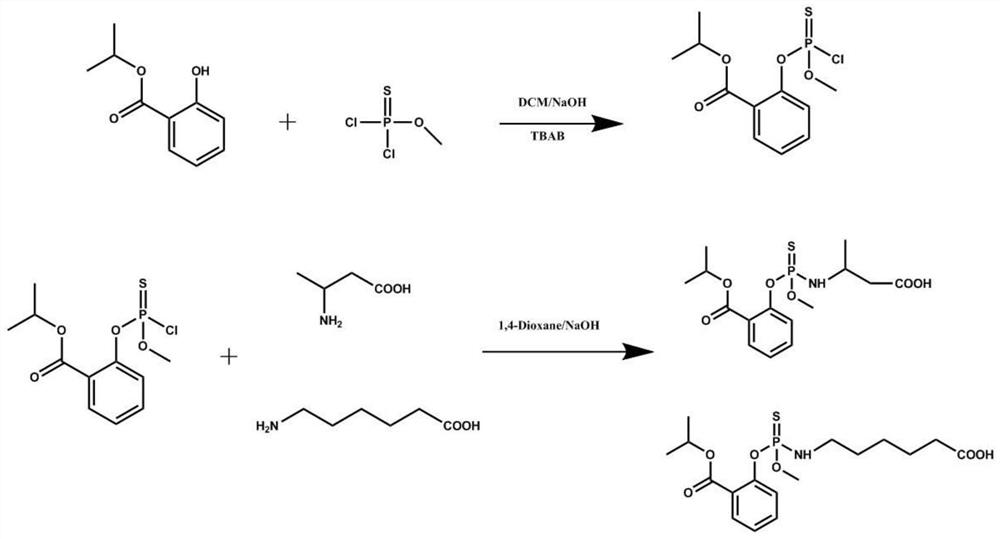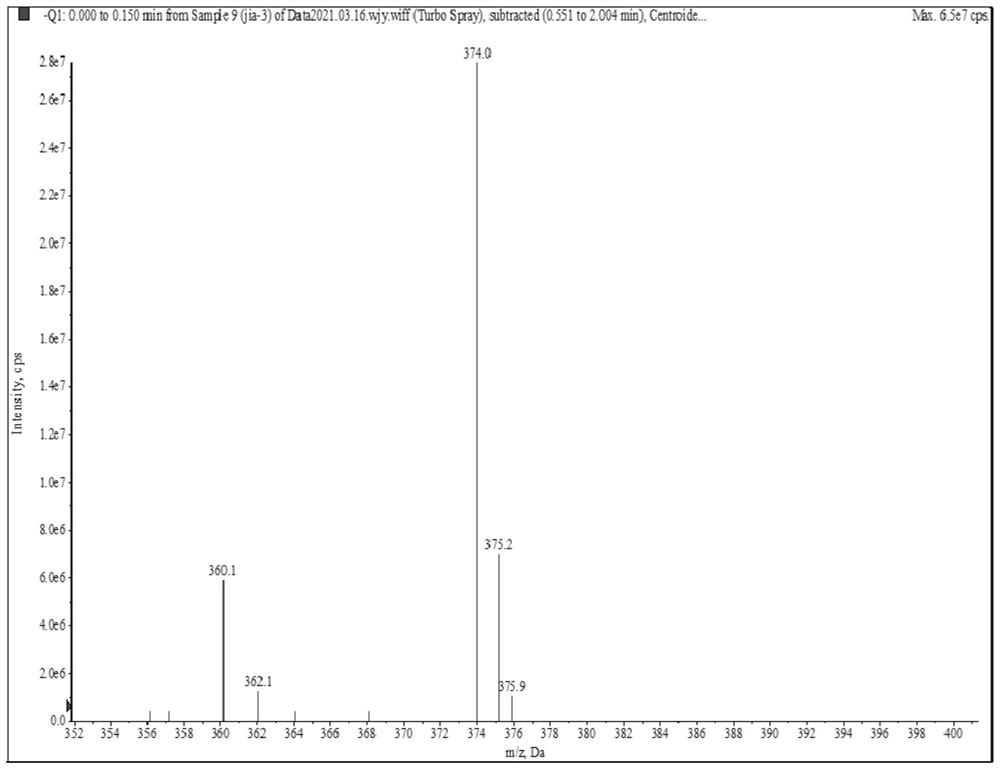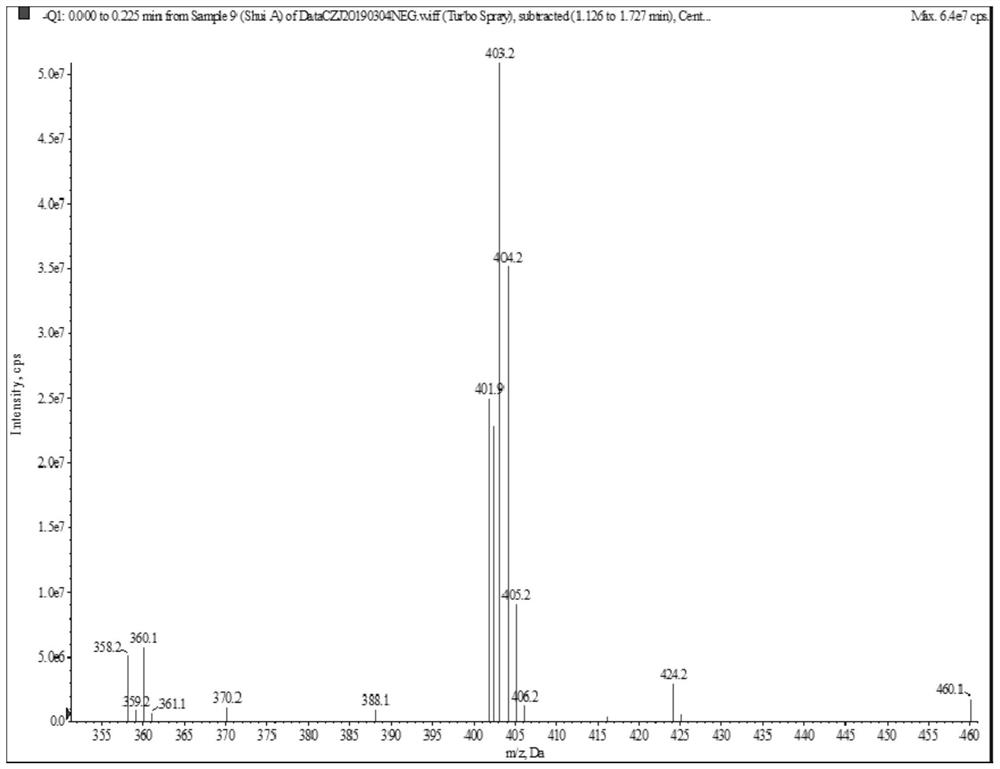Monoclonal antibody capable of simultaneously detecting isofenphos-methyl and isocarbophos and application thereof
A technology of monoclonal antibody and isofenphos-methyl, which is applied in the direction of microorganism-based methods, measuring devices, chemical instruments and methods, etc., can solve the problem of low sensitivity and achieve the effect of high sensitivity and strong specificity
- Summary
- Abstract
- Description
- Claims
- Application Information
AI Technical Summary
Problems solved by technology
Method used
Image
Examples
Embodiment 1
[0044] Example 1 Synthesis of isofenphos-methyl and isocarbophos hapten
[0045] 1. Experimental method
[0046] Synthesis of isofenphos-methyl and isocarbophos haptens, the specific synthesis process see figure 1 .
[0047] 1. Synthesis of hapten shown in formula (I)
[0048]
[0049] Take 3.6g of isopropyl salicylate, 3g of O-methyl phosphorothioate dichloride, 0.5g of TBAB dissolved in 10mL of dichloromethane (DCM) and stir, 0.5g of NaOH dissolved in 10mL of tertiary water, add the above DCM solution, stirred vigorously to make the organic-aqueous phase layer interface disappear, and stirred overnight. Transfer to a separatory funnel, and after the layers are separated, the organic phase of the lower layer is removed and rotary evaporated to obtain the intermediate product shown in formula (III). After 400-mesh silica gel chromatography, the mobile phase is petroleum ether, and the purified intermediate product is obtained after separation and purification. Take 0.5...
Embodiment 2
[0056] Example 2 Synthesis and Identification of Artificial Antigen
[0057] 1. Experimental method
[0058] 1. Artificial antigen synthesis shown in formula (IV)
[0059] Dissolve 9.4 mg of the hapten represented by formula (I) in 600 μL of N,N-dimethylformamide, then add 1-(3-dimethylaminopropyl)-3-ethylcarbodiimide salt under stirring acid salt and N-hydroxysuccinimide, and stirred at room temperature for 4 hours in the dark to obtain the activated hapten, which is called A solution. Wherein, the mol ratio of the hapten shown in formula (I), the 1-(3-dimethylaminopropyl)-3-ethylcarbodiimide hydrochloride and the N-hydroxysuccinimide is 1:1.5:1.5. Dissolve 20mg of bovine lactoferrin (LF) in pH 9.6 carbonic acid buffer solution with a bovine lactoferrin concentration of 10mg / mL, which is called liquid B. The above liquid A was added dropwise to the liquid B under stirring in an ice bath, the molar ratio of the hapten in the liquid A having the structural formula shown in ...
Embodiment 3
[0072] Example 3 Preparation of Monoclonal Antibodies that Can Simultaneously Detect Isofenphos-methyl and Isocarbophos
[0073] 1. Experimental method
[0074] Get 6-8 weeks old Balb / c mice (Zhuhai Baishitong Biotechnology Co., Ltd.), and immunize the antigen with the artificial antigen shown in formula (IV-1) at a concentration of 1 mg / mL prepared in Example 2 and Freund's complete adjuvant Mix equal amounts of the same doses, and after complete emulsification, inject 100 μL into the abdomen and back of mice. Freund's complete adjuvant was used for the first immunization, and Freund's incomplete adjuvant was used for subsequent booster immunizations, and immunization was performed every 2 weeks, and a total of 3 booster immunizations were performed. One week after the second booster immunization, blood was taken from the tail vein to test the titer and inhibition. After the third booster immunization, mice with higher titer and inhibition rate were selected for cell fusion...
PUM
 Login to View More
Login to View More Abstract
Description
Claims
Application Information
 Login to View More
Login to View More - R&D
- Intellectual Property
- Life Sciences
- Materials
- Tech Scout
- Unparalleled Data Quality
- Higher Quality Content
- 60% Fewer Hallucinations
Browse by: Latest US Patents, China's latest patents, Technical Efficacy Thesaurus, Application Domain, Technology Topic, Popular Technical Reports.
© 2025 PatSnap. All rights reserved.Legal|Privacy policy|Modern Slavery Act Transparency Statement|Sitemap|About US| Contact US: help@patsnap.com



